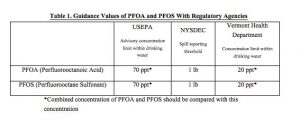Since the recent discovery of high concentration levels in the Hoosick Fall’s water wells and with Gabreski Air National Guard Base being declared a New York State Department of Environmental Conservation (NYSDEC) State Superfund Site, PFOA and PFOS and their effect on our health have been a hot topic of conversation. Perfluorooctanoic Acid (PFOA) and Perfluorooctane Sulfonate (PFOS) are synthetic (manmade) organic compounds used in consumer products, industrial products, and food items to make them resistant to stains, grease, and water. PFOA and PFOS have been used in production systems for over 40 years. PFOA and PFOS have since been shown to be resistant to environmental breakdown, and thus will remain in the environment unchanged for long periods of time. They remain unchanged within humans and animals, and will remain within the body for many years. Some studies have shown correlations, but not a direct cause-effect relationship, to elevated PFOA and PFOS levels in humans to high blood pressure, decreased birth weights in babies, immune system effects, thyroid disease, and kidney and testicular cancer. The manufacturing industry has since voluntarily stopped using PFOA and PFOS and phased them out of production in 2015.
Based on recent findings, the United States Environmental Protection Agency (USEPA) established health advisories for PFOA and PFOS to allow those who oversee drinking water systems to provide information on health risks of those chemicals. A health advisory provides information on contaminates, but is non-enforceable and is not a regulation; they provide technical information for those who need it.
You may ask, PFOA and PFOS are in drinking water, now what? Using the USEPA’s health advisory, and as requested by the New York State Department of Health (NYSDOH), NYSDEC filed a Notice of Emergency Adoption and Proposed Rule Making to classify PFOA and PFOS as hazardous substances. This was done due to evidence found by the NYSDEC and NYSDOH that showed exposure to the compounds could pose a threat to public health. The emergency rule originally went into effect in April 2016, and was renewed in September 2016. The NYSDEC has stated they will continue to file temporary Emergency Adoptions as needed until final changes to 6 NYCRR Part 597 “Hazardous Substances Identification, Release Prohibition, and Release Reporting” are completed, listing PFOA and PFOS as hazardous substances.
Below is a brief table summarizing the current limits and advisories for PFOA and PFOS.
NYSDEC has the authority to regulate the handling and storage of hazardous substances and can require remediation of sites where PFOA and PFOS exist. All handling and storage of PFOA and PFOS will follow NYSDEC Chemical Bulk Storage regulations, 6 NYCRR 596-599.
If you or your business has any questions regarding PFOA and PFOS storage, handling, regulations, health concerns, or past usage, please call Walden Environmental Engineering at (516)624-7200.


